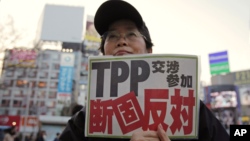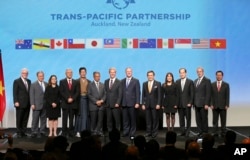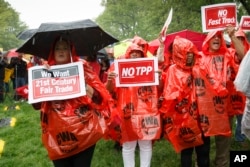Governments and business in Asia are preparing to place greater focus on regional trade and economic prospects, following the U.S. decision to withdraw from the 12 nation Trans Pacific Partnership agreement or TPP.
Analysts say alternative multilateral trade pacts including the Regional Comprehensive Economic Partnership (RCEP), which includes China, may fill the ‘vacuum’ left by the absence of TPP.
The decision, which President Donald Trump called a “great thing for the American worker” – had been anticipated by the region as it had been a key pledge by Trump during his election campaign last year.
The trade deal, covering nearly 40 percent of the global economy and about a third of global trade, was initiated by countries within Asia before the U.S. joined in the talks that began in 2009.
The TPP was a hallmark of former President Barack Obama’s tenure as part of a policy pledge to pivot the U.S. towards Asia to counter China’s growing regional influence.
Bilateral agreements
Trump says he is looking to bilateral trade agreements, charging U.S. multinational trade deals had cost American workers their jobs, as employers moved operations abroad to seek out lower labor costs.
But Carl Thayer, a political scientist at Australia’s University of New South Wales, said the U.S. withdrawal from the TPP will undermine U.S. influence in Asia.
“The political ramifications is that one arm of the U.S. rebalance (to Asia) has been taken off and President Trump has stated when he signed it – he’s only going to bilateral (agreements). At this moment he’s given away multilateral (pacts) so the U.S. no longer has a leadership role using the economic lever in Southeast Asia,” Thayer said.
Global trade has been a key source of economic expansion in Asia over the past six decades, built around multilateral trade agreements.
Alternatives
Analysts say in the TPP’s absence, regional countries will seek alternative trade pacts, including the RCEP, and the Association of South East Asian Nations (ASEAN) initiative that includes China and India.
Malaysia’s International Trade and Industry Deputy Minister, Datuk Ahmad Maslan, said Malaysia was looking to alternatives, including the RCEP, expected to be finalized by the end of 2017.
“So if we focus on the RCEP, we will not face any major loss in the face of the TPP’s collapse,” Ahmad Maslan told local media.
But there were also key additions made to the TPP agreement by the Obama team that separated it from other standard trade agreements. "The TPP had included strengthening intellectual property protections, promoting competitive and transparent business laws as well as enforcing labor and environmental standards" according to a statement from the U.S. Council on Foreign Relations.
Pavida Pananond, a professor of international business studies at Thammasat University, said uncertainties over the U.S. market would naturally lead to a greater focus on Asia regional trade and business.
“The regional focus would be strengthened because of the uncertainty in the U.S. market. If you look at East and Southeast Asia, there is already the tendency to look to the RCEP as the kind of alternative multi-plural agreement that people would pay attention to,” Pavida said.
She added that in the event of increased tariffs in the U.S., it may lead to greater foreign direct investment in the U.S. by Asian firms seeking access to the U.S. market.
Thayer said the TPP and RCEP agreements stand in contrast.
“The RCEP was an ASEAN initiative – to take its web of bilateral relationships and create a multilateral arrangement. But it would have been of a lower standard – sort of silver standard – rather than the gold standard of TPP,” Thayer said.
Analysts say the U.S. policy of “America First” to favor U.S. business at home, marks a trend of growing trade protectionism and isolation of the U.S. in relations with Southeast Asia.
Will US reconsider ?
Australia and Japan, key TPP member states, say they are still hoping the U.S. may reconsider its stance in the months ahead.
Australian Prime Minister Malcolm Turnbull said the Republican Party in the U.S. Congress had been “strong supporters of the TPP.” He said incoming secretary of State, Rex Tillerson, had been a long-time advocate for the pact.
“It is possible the U.S. policy could change over time on this as it has done on other trade deals. There is also the opportunity for the TPP to proceed without the United States,” Turnbull told Australian media.
A Japanese official told the press that the TPP pact is “meaningless” without U.S. participation. He added that Prime Minister Abe will keep trying to convince President Trump of the merits of the trade deal.
Analysts say in late November during the meeting of Asia Pacific Economic Community (APEC) states in Lima, Peru, soon after the U.S. elections, leaders met to map out a strategy in the event of the U.S. withdrawing from the TPP.
Thayer says there may still be a chance for renegotiation – a TPP Mark 2 – that may include the U.S before the final deadline in January 2018.
“The details – find out what details are in the TPP that (the President) doesn’t like and they can be renegotiated. So there’s hope, there’s a dim light at the end of the tunnel; it’s getting dimmer but it’s not dead yet. And January 2018 would mark the period,” Thayer said.
But other analysts say the TPP will be far weaker without American involvement, saying the U.S. withdrawal was a missed opportunity for free trade in the region.







